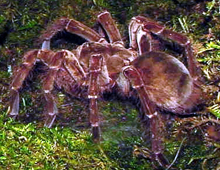
“Exploring the Enigmatic Goliath Bird-Eating Tarantula”
The Goliath bird-eating tarantula (Theraphosa blondi) is a creature that inspires both fascination and fear among those who encounter it. As one of the largest spiders in the world, this impressive arachnid possesses a range of unique characteristics and behaviors that set it apart from its smaller relatives.
Physical Appearance
True to its name, the Goliath bird-eating tarantula is an imposing sight to behold. With a leg span reaching up to 30 centimeters (12 inches) and a body size comparable to that of a dinner plate, it commands attention wherever it roams. Its hairy body and distinctive patterns contribute to its intimidating appearance, while its formidable fangs and venomous bite serve as effective tools for subduing prey.
Habitat and Range
Native to the rainforests of South America, particularly in regions such as Brazil and Venezuela, the Goliath bird-eating tarantula inhabits humid, tropical environments characterized by dense vegetation and abundant prey. It typically dwells in underground burrows or hides within hollow trees, emerging primarily at night to hunt for food.

Diet and Feeding Behavior
Despite its name, the Goliath bird-eating tarantula does not exclusively prey on birds. Instead, it is an opportunistic hunter that feeds on a variety of small animals, including insects, amphibians, reptiles, and even small mammals. While capable of capturing and consuming birds, particularly fledglings or small species, such instances are relatively rare.
When hunting, the Goliath bird-eating tarantula relies on stealth and ambush tactics, using its keen sense of touch and vibration detection to detect nearby prey. Once within striking range, it immobilizes its victim with venom before using its powerful fangs to deliver a lethal bite. Contrary to popular belief, its venom is not typically harmful to humans, causing only mild irritation or discomfort.
Conservation Status
Despite its imposing size and fearsome reputation, the Goliath bird-eating tarantula faces threats to its survival, primarily due to habitat destruction and collection for the exotic pet trade. While it is not currently listed as endangered, conservation efforts are underway to protect its natural habitat and regulate its trade to ensure sustainable populations in the wild.
Cultural Significance
In indigenous cultures of South America, the Goliath bird-eating tarantula holds various symbolic meanings and cultural significance. It is often depicted in folklore and mythology as a creature of power and mystique, revered for its strength and resilience in the face of adversity.
In conclusion, the Goliath bird-eating tarantula stands as a testament to the remarkable diversity of life on our planet. Despite its formidable appearance, this enigmatic arachnid plays a vital role in its ecosystem and continues to captivate the imagination of enthusiasts and researchers alike with its awe-inspiring presence.






